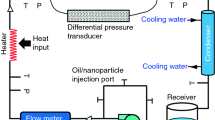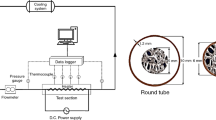Abstract
Heat transfer of viscoelastic liquids in five flattened tubes with aspect ratios ranging from 1.4 to 5.7 were presented. Water was used as the heating medium; and solutions of polyacrylamide were used as the viscoelastic solutions. Heat transfer increase from flattening was 101% higher while secondary flow contributed a maximum increase of 65% for the 250 ppm solution and about 85% for the 500 ppm solutions at an aspect ratio of 1.6.







Similar content being viewed by others
Abbreviations
- a:
-
Major axis
- A:
-
Area
- b:
-
Minor axis
- c:
-
Straight section of the flattened tube cross-section = a−b
- cp :
-
Specific heat
- C:
-
Constant
- d:
-
Original tube diameter
- de :
-
Equivalent diameter
- dc :
-
Characteristic dimension
- F, G, H:
-
Shear rate functions
- F0, G0, H0 :
-
Shear rate functions coefficients
- Gz:
-
Greatz number
- Gze :
-
Graetz number using equivalent diameter
- hc :
-
Heat transfer coefficient, circular tube
- hf :
-
Heat transfer coefficient, flattened tube
- k:
-
Thermal conductivity
- K:
-
Material constant
- K’:
-
Constant in Graetz–Leveque equation
- L:
-
Length
- Nu:
-
Nusselt number
- Nue :
-
Nusselt number using equivalent diameter
- Nul :
-
Local Nusselt number
- p:
-
Aspect ratio
- P:
-
Pressure gradient
- q:
-
Heat flux
- qr :
-
Shear rate
- Q:
-
Volumetric flow rate
- Q1 :
-
Flow rate for central region, flattened tube
- Q2 :
-
Flow rate for semi-circular ends, flattened tube
- R:
-
Radius
- t:
-
Time
- T:
-
Temperature
- T1 :
-
Inlet temperature
- T2 :
-
Outlet temperature
- Tw :
-
Wall temperature
- ΔTA :
-
Temperature difference between the two streams at entry
- ΔTB :
-
Temperature difference between the two streams at exit
- ΔTLM :
-
Log mean temperature difference
- U:
-
Overall heat transfer coefficient
- v:
-
Velocity
- vmax :
-
Peak velocity
- vs :
-
Secondary flow velocity
- w:
-
Mass flow rate
- W:
-
Watt
- γ:
-
Strain
- λ1 :
-
Relaxation time
- λ2 :
-
Retardation time
- ρ:
-
Density
- τ:
-
Shear stress
- μw, μb :
-
Viscosity at wall, bulk viscosity
- Φ:
-
Geometric factor
References
Bott TR (1966) Design of scraped surface heat exchangers. British Chem Eng 2(5):338–339
Bott TR (2001) To foul or not to foul. Chem Eng Prog Mag 97(11):30–37
Bott TR, Romero JJB (1963) Heat transfer across a scraped surface. Can J Chem Eng 41:213–219
Chong A (2001) A study of scraped-surface heat exchanger in ice-making applications. M.Sc. Thesis. University of Toronto
Tähti T (2004) Suspension melt crystallization in tubular and scraped surface heat Exchangers. Ph. D. Thesis. Martin-Luther-Universität
Song L (2008) Vibration actuation system with independent control of frequency and amplitude. Free Patent on Line, Patent Application: 20100193159
Nassauer L, Kessler HG (1986) The effect of electrostatic phenomena on the cleaning of surfaces. Chem Eng Process 20(1):43–52
Pattenden RF, Richards AD (1964) Heat transfer from a rotating tube with controlled fluid flow. Arch J Mech Eng Sci 6:144–149
Liu S, Masliyah JH (1994) Developing convective heat transfer in helical pipes with finite pitch. Int J Heat Fluid Flow 15(1):66–74
Yang R, Chang CF (1994) Combined free and forced convection for developed flow in curved pipes with finite curvature ratio. Int J Heat Fluid Flow 15:470–476
Green AE, Rivlin RS (1956) Steady flow of non-Newtonian fluids through tubes. Q Appl Math 14(1956):299–308
Carlson LW, Irvine TF Jr (1961) Fully developed pressure drop in triangular shaped ducts. J Heat Transf 83:441–444
Deissler RG, Taylor MF (1958) Analysis of turbulent flow and heat transfer in noncircular passages. NACA Technical Note 4384
Mitsuishi N, Kitayama Y, Aoyagi Y (1966) Flow of power-law fluids in a duct of arbitrary cross section and triangular ducts. Int Chem Eng 8:168
Middleman S (1965) Flow of non-Newtonian fluids in narrow rectangular channels. Trans Soc Rheol 9(1):83–93
Sparrow EM (1962) Laminar flow in isosceles triangular ducts. Am Inst Chem Eng J 8(5):599–604
Beyer CE, Towsley FE (1952) The flow of polystyrene through rectangular channels. J Colloid Sci 7(3):236–243
Hartnett JP, Kostic M (1985) Heat transfer to a viscoelastic fluid in laminar flow through a rectangular channel. Int J Heat Mass Transf 28(6):1147–1155
Rao RB (1989) Laminar mixed convection heat transfer to viscoelastic fluids in a 5:1 rectangular channel. Int J Heat Fluid Flow 10(4):334–338
Wheeler JA, Wissler EH (1965) The friction factor-Reynolds number relation for the steady flow of pseudo plastic fluids through rectangular ducts. Am Inst Chem Eng J 11:207–216
Mitsuishi N, Aoyagi Y (1969) Non-Newtonian flow in non-circular ducts. Chem Eng Sci 24(2):309–319
Ray S, Date AW (2003) Friction and heat transfer characteristics of flow through square duct with twisted tape insert. Int J Heat Mass Transf 46:889–902
Oliver DR, Karim RB (1971) Laminar-flow non-Newtonian heat transfer in flattened tubes. Can J Chem Eng 49(2):236–240
Siginer DA, Letelier MF (2005) Heat transfer in laminar flow of viscoelastic fluids in straight tubes of arbitrary shape. Annu Trans Nord Rheol Soc 13:137–145
Metzner AB, White JL, Denn MM (1966) Constitutive equations for viscoelastic fluids for short deformation periods and for rapidly changing flows: significance of the Deborah Number. Am Inst Chem Eng J 12(5):863–865
Metzner AB, White JL (1965) Flow behavior of viscoelastic fluids in the inlet region of a channel. Am Inst Chem Eng J 11(6):989–995
Oldroyd JG (1950) On the formulation of rheological equations of state. Proc R Soc Lond A200:523–541
Karim RB (1973) Pressure drop of a viscoelastic system in flattened tubes. Sains Malays 2(2):77–81
Semjonow VV (1967) Pressure effect of viscosity for polymer fluids. Rheol Acta 6(2):171
Oliver DR (1969) Secondary flow of viscoelastic liquids in flattened tubes. Trans Inst Chem Eng 47:T18
James PA (1970) Forced convection heat transfer in narrow passages. Can J Chem Eng 48:330–332
Author information
Authors and Affiliations
Corresponding author
Rights and permissions
About this article
Cite this article
Ismail, Z., Karim, R. Determination of optimum aspect ratio for laminar flow heat transfer of dilute viscoelastic solutions in flattened tube heat exchangers. Heat Mass Transfer 48, 1319–1331 (2012). https://doi.org/10.1007/s00231-012-0981-2
Received:
Accepted:
Published:
Issue Date:
DOI: https://doi.org/10.1007/s00231-012-0981-2




